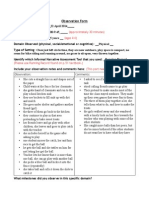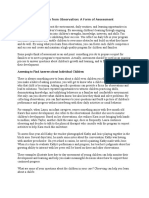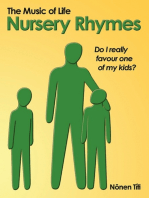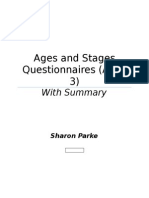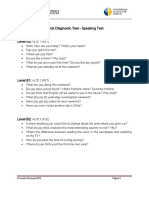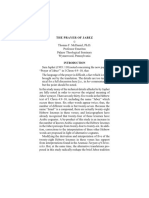3 Finalfinalidp
3 Finalfinalidp
Uploaded by
api-237173553Copyright:
Available Formats
3 Finalfinalidp
3 Finalfinalidp
Uploaded by
api-237173553Original Title
Copyright
Available Formats
Share this document
Did you find this document useful?
Is this content inappropriate?
Copyright:
Available Formats
3 Finalfinalidp
3 Finalfinalidp
Uploaded by
api-237173553Copyright:
Available Formats
Running head: INDIVIDUAL DIFFERENCES STUDENT PROFILE
Individual Differences Student Profile
Amber L Avila
College Of Southern Idaho
Professor Tracey J. Meyerhoeffer
EDUC 205: Development/Individual Differences
Fall 2014
IDP 1
Individual Differences Student Profile
IDP 2
Individual Differences Student Profile
Student come in all shapes and sizes. Some have above average skills and some have
below average skills. They also all have family, social, and educational experiences that have
made them into who they are. I have the privilege of working with extraordinary students, some
of which suffer from varying disabilities. There is one student I have worked with on several
occasions that I adore. This is whom I chose to observe for this project. She has been classified
as having Autism. Autism is a general term that describes a set of disabilities. The unique
parameters of this disability are what make up its classification. There are no two cases of
Autism that are alike. The following profile provides details about a students physical,
cognitive, and social emotional development, in comparison to other children the same age. I
used informal methods of assessment to collect data through my observations.
General Information
Ann is a female who is eight years and five months old. Some people would describe her
as disabled, but to me she is exceptional. She is full of life and energy. She sees the world
through a different set of lenses. For the sake of privacy and confidentiality, I gave her the name
Ann. Her story begins on July 17, 2006, the day she was born. Her mother is African American
and Caucasian. Her dad is Filipino and Caucasian. She has five other people in her family. Her
mom, dad, one brother, and two sisters all live with her in the same house. The time she spends
at school is the same time as her classmates. They arrive at school at 7:45 a.m. and then when
school is finished at 2:25 p.m., she rides the bus back home where she stays with her mom, dad,
or grandma. She doesnt attend any type of daycare program. There is always a family member
who cares for her when she isnt at school.
Physical Development
Individual Differences Student Profile
IDP 3
Ann is a cute, little girl with dark-brown, shoulder-length hair and big, beautiful, brown
eyes. She has a light-brown skin tone and a big, bright smile. If one was to see her from a
distance, he/she would never guess that she has a disability. Of course, once she tries to speak,
one can tell that she is different from other children her age, but she is the same height as her
peers and about the same physical build also.
Although she physically looks the same, there are health problems that come along with
her disability. Her hearing and vision seem to be close to normal, and there are no records of her
having any hearing or vision loss. There is one distinct health concern that she was born with,
chronic seizures. They used to occur really close together and last for long periods of time.
They are now more sporadic, and when she has an episode, it doesnt last but a minute or two.
Her doctors believe that the reason for her having fewer seizures is the medication that she is on
now. They are still in the process of figuring out what works for her, and her treatment changes
with her needs.
The other thing that keeps the professionals and her family puzzled is which hand is
dominant for her. When working on art projects or when she eats, she uses both hands equally so
her handedness is still a mystery. She seems to be very active. She enjoys PE and also taking
long walks outside when the weather is nice. She does have some large-muscle development
and is able to kick and throw a ball randomly but not in a specific direction. She loves to dance
and listen to music. Anns small-muscle development is functioning. She is able to push small
buttons, use a paint brush, and draw scribbles with a pencil. She is unable to draw shapes,
letters, or numbers. She always has to be holding something in her hand. The object could be
anything from another persons hand to a toy. This seems to anchor her, and she does better
moving from one place to another or transitioning between activities when she is holding
something.
Individual Differences Student Profile
IDP 4
Her eating habits vary, but right now she really likes peanut butter and could eat large
amounts for every meal. In the morning, if she doesnt eat much of her hot school breakfast, one
of her teachers will make her scrambled eggs when she gets to the classroom, and she eats them
without any hesitation. She is accompanied to the lunchroom by her teacher everyday where she
eats a hot school lunch. She usually only finishes about half of her meal before she becomes
uninterested and wants to be finished eating. Every afternoon, she is given a snack of crackers
and peanut butter so she doesnt get on the bus hungry. In all, milk seems to be the only food
choice that she will not partake of at home or school.
Cognitive Development
Individual Differences Student Profile
IDP 5
Ann spends most of her day in the resource room with her special-education teachers.
There is a short period of time in the morning, usually no more than fifteen minutes, when she
participates in her general-education, second-grade classroom. She personally cannot last for
any longer than that with her peers before she becomes disruptive, knocking boxes of blocks or
books onto the floor. At this time, there is not a standard grading system that her teachers use to
record her successes. They are using a multi-sensory approach but the most successful tool so
far has been a visual schedule. As far as academics, she is unable to read, but she can recognize
pictures, and that is how her teacher plans out her day. Her teacher uses visual cues with a
schedule. The schedule has pictures of people, places, and familiar items on it that show a
specific order of steps she needs to follow. For example, the last three activities of the day could
be library, bathroom, and then home. Those items on her schedule are represented by pictures of
the places (library and bathroom) and pictures of objects (her backpack) that are cues to prompt
her and/or keep her on track. These visual supports assist with breaking down each task into
smaller steps. They teach her vocabulary in a variety of contexts, and they are used as signals so
that she knows when transitions will occur. Visual communication aids are being used also. One
specific aid is Anns topic board that contains picture symbols of basic vocabulary words and
actions that provide her with more opportunities for her to make a choice. Since she doesnt have
an extended verbal vocabulary, these picture symbols give her the opportunity to point out what
she would like to do next or give her the opportunity to respond to a command.
Individual Differences Student Profile
IDP 6
To achieve Anns goals, her teachers are working in her zone or proximal development
which according to the theorist, Lev Vygotsky, refers to the tasks that the child is not yet
capable of doing herself, but may accomplish if she is given assistance (Parsons, Hinson, &
Sardo-Brown, 2001, p.54). Vygotsky attended the Institute of Phycology in Moscow, and came
up with he calls a sociocultural approach to cognitive development (Parsons, Hinson, & SardoBrown, 2001, p.54). With these visual aids, Ann has made progress and is now able to follow a
general schedule. Her art and music teachers have been really good about adapting the activities
for her, and she is now able to last longer than her typical fifteen minutes in those non-general
education classes.
The first psychologist to develop a systematic study of cognitive development was Jean
Piaget. Using Piagets suggested stages of development found in his study, I would say that Ann
is still in the sensorimotor stage. This is the first stage of development where a child moves from
reflexive activities needed for survival, such as sucking and grasping, to the development of
object permanence which is more complex and discovered in the latter phase of this same stage
(Parsons, Hinson, & Sardo-Brown, 2001, p.35). She is still discovering the world by seeing,
hearing, and touching objects. A milestone of this stage is problem solving. Once she shows
significant progress, she will move onto the other stages of development that are more advanced
in cognitive development.
Individual Differences Student Profile
IDP 7
Her language development and syntax is improving. Expanding her word base is one of
the goals that her special-education teacher has set for her this year. Independently, she is able to
produce a variety of sound combinations such as mama, and bebe. When interacting with
others, she has one-word productions that include hi, bye, eat, juice, help, please, and
bubble. When given prompts, she will repeat two-word productions like sit down, more
please, help baby, and more bubbles. She also uses gestures such as pointing or waving as
symbols for things like come here or all done.
Social Emotional Development
Ann likes to be around other children. Her peers accept her and this is evidenced by their
interactions with her. They hold her hands and let her give them hugs. Even though these
interactions with peers last only a couple of minutes, she seems to really enjoy them. Unlike last
years, she also is capable of interacting with adults in a positive manner. She no longer has the
constant tendency to slap the adults that work with her because they have started replacement
behaviors like clapping or giving a high five when she raises her hand. The teacher noticed that
since this replacement method has been implemented, there have been far fewer occurrences of
her slapping anyone.
Ann doesnt seem to lack self- esteem. Her level of confidence is high enough that she
doesnt worry about what others think about her. It was obvious that when her teachers
acknowledge her completion of a task and said things to her like good job she understood them
and she responded to them with a smile.
Individual Differences Student Profile
IDP 8
Socio-emotional development is part of a theory presented by Erik Erikson who studied
how personalities develop through a series of stages. He discovered that our relationships with
other people evolve throughout a process of psychosocial development. Our own identities are
shaped and molded through these relationships (Parsons, Hinson, & Sardo-Brown, 2001, p.87).
Ann is still in the first stage of psychosocial development, trust verses mistrust. I believe that
she has developed a sense of trust in her teachers and the other adults that work with her. She has
also built trust with her peers. She rarely has meltdowns at school and seems to really enjoy
being there. She appears to feel safe and secure in her school environment. Her teachers have
accomplished this trust with consistent, predictable routines. Additionally, they have set up an
engaging environment where she can experience the other stages, but she isnt able, at this point,
to make significant progress moving into the next stage of autonomy. There are opportunities,
however, for her to interact with the other students in the resource room and she is able to
practice independence where there is a teacher close by in case she needs assistance. Although
she hasnt gotten to the place where she executes tasks completely independently, the
opportunities are still there for her when she is ready. In all, her teachers have set boundaries
where there is consistency and clarity in what is expected and what the consequences will be.
Summary of Findings
Ann seems to be changing and growing every day. Even if her steps are small, she is
working really hard to learn new things. All of this will help her be a successful student as she
continues to grow. She isnt at a typical level of development for a child her age but she has
come a long way since starting school.
Individual Differences Student Profile
IDP 9
In the area of general development, she is at a typical level because she looks like a
typical 2nd grader does. If one looks deeper into her physical, cognitive, and socio-emotional
development level, he will see that her peers far exceed the stages where she is currently
operating. Even if she looks like a 2nd grader, she isnt able to physically do the same things as
other 2nd graders. Her large-muscle and small-muscle development are not at typical levels and
actually well below that of her peers. Her cognitive level of development is at a preschool level
or even below that level along with her socio-emotional development when compared to other
children her age.
Conclusion
Even with Anns development being behind her peers, she still has some strengths in her
development. She is trainable when being taught a new skill. She is also able to hold eye
contact when given directions, and both of these skills will be useful in her development. They
will help her be successful and move her towards being more independent. The specific
strategies that her teachers are using to help her develop and to help her reach her goals for this
year are visual mini-schedules and the method of first this, then that. They believe that with
little steps, as well as being flexible and consistent, they will reach the place where she is a selfsufficient, independent student.
Individual Differences Student Profile
IDP 10
References
Parsons, R. D., Hinson, S. L., & Sardo-Brown, D. (2001). Educational (indent 2nd and 3rd lines
of citation)psychology: A practitioner-research model of teaching (1st ed.), p. 35,54,& 87. (D.
Lindsay, Ed.) Belmont, CA: Wadsworth/Thomson Learning.
You might also like
- Parent Interview Reflection PaperDocument4 pagesParent Interview Reflection Paperapi-449648328No ratings yet
- Child Observation 145Document9 pagesChild Observation 145api-257580746100% (1)
- Pepsi ScreeningDocument11 pagesPepsi Screeningapi-584410222No ratings yet
- Idsp Final PaperDocument8 pagesIdsp Final Paperapi-434808297No ratings yet
- 205 FinalDocument7 pages205 Finalapi-524660719No ratings yet
- Running Head: Individual Differences Student Profile 1Document10 pagesRunning Head: Individual Differences Student Profile 1api-355529416No ratings yet
- Mejia S Sped854 m7 FamilyinterviewDocument4 pagesMejia S Sped854 m7 Familyinterviewapi-298015720No ratings yet
- Pepsi ScreeningDocument17 pagesPepsi Screeningapi-518987646No ratings yet
- Running Head: Individual Differences Student Profile EssayDocument9 pagesRunning Head: Individual Differences Student Profile Essayapi-263184109No ratings yet
- Pepsi ScreeningDocument13 pagesPepsi Screeningapi-549253108No ratings yet
- Final Idsp Final FinalDocument9 pagesFinal Idsp Final Finalapi-455194813No ratings yet
- P.E.P.S.I. ScreeningDocument12 pagesP.E.P.S.I. Screeningapi-534303487No ratings yet
- Rachel Merson Pepsi ScreeningDocument11 pagesRachel Merson Pepsi Screeningapi-542540778No ratings yet
- Final IdspDocument7 pagesFinal Idspapi-314873201No ratings yet
- Temperament ReportDocument8 pagesTemperament ReportNaomi AkuokoNo ratings yet
- ArlenyDocument10 pagesArlenyapi-273326685No ratings yet
- Pepsi ScreeningDocument12 pagesPepsi Screeningapi-519165689No ratings yet
- Pepsi Final DraftDocument14 pagesPepsi Final Draftapi-458486566No ratings yet
- Edu 220 PepsiDocument11 pagesEdu 220 Pepsiapi-393294783No ratings yet
- Pepsi Edu220Document12 pagesPepsi Edu220api-457619130No ratings yet
- Bordi Educ205 c02w IdpDocument6 pagesBordi Educ205 c02w Idpapi-401252208No ratings yet
- Pepsi ScreeningDocument11 pagesPepsi Screeningapi-549044186No ratings yet
- Idsp Final PaperDocument8 pagesIdsp Final Paperapi-356500927No ratings yet
- Pepsi Screening Results-1Document8 pagesPepsi Screening Results-1api-611642914No ratings yet
- Sherrigenna Individual Difference Student ProfileDocument8 pagesSherrigenna Individual Difference Student Profileapi-356514016No ratings yet
- Individual Differences Student ProfileDocument7 pagesIndividual Differences Student Profileapi-283624871No ratings yet
- Abecassandrahernandezfa 22Document7 pagesAbecassandrahernandezfa 22api-679365507No ratings yet
- Thesis 10 28 15 No AppendixDocument61 pagesThesis 10 28 15 No Appendixapi-203628992No ratings yet
- Pepsi Screening PDFDocument10 pagesPepsi Screening PDFapi-527125890No ratings yet
- Observation PaperDocument6 pagesObservation Paperapi-317940715No ratings yet
- Running Head: EDU 220 PEPSI 1Document16 pagesRunning Head: EDU 220 PEPSI 1api-554845801No ratings yet
- Child Case Study 2Document7 pagesChild Case Study 2api-314700266No ratings yet
- Edu 220 Pepsi Case StudyDocument11 pagesEdu 220 Pepsi Case Studyapi-499990657No ratings yet
- Running Head: CASE STUDY 1: Randy Boschetti Portfolio Artifact: Case Study Edu 220 May 4th, 2016Document14 pagesRunning Head: CASE STUDY 1: Randy Boschetti Portfolio Artifact: Case Study Edu 220 May 4th, 2016api-317624906No ratings yet
- Teacher Research ProposalDocument11 pagesTeacher Research Proposalapi-501003650No ratings yet
- Idsp MayganharrisonDocument7 pagesIdsp Mayganharrisonapi-384958380No ratings yet
- Maisano - Pepsi Project Edu220Document10 pagesMaisano - Pepsi Project Edu220api-526786957No ratings yet
- Using What You Learn From ObservationDocument6 pagesUsing What You Learn From Observationapi-295870335No ratings yet
- Case Study of Child eDocument8 pagesCase Study of Child eapi-245185556No ratings yet
- CASES Related DisordersDocument9 pagesCASES Related DisordersEvelyn WeaverNo ratings yet
- Pepsi Screening FinalDocument8 pagesPepsi Screening Finalapi-385528557No ratings yet
- Overview Diversity ProjectDocument13 pagesOverview Diversity Projectapi-349463576No ratings yet
- Running Head: Individual Differences Student Profile Essay Idp 1Document7 pagesRunning Head: Individual Differences Student Profile Essay Idp 1api-391016070No ratings yet
- 1 Running Head: PEPSI SCREENINGDocument11 pages1 Running Head: PEPSI SCREENINGapi-296983580No ratings yet
- InterveiwessayDocument9 pagesInterveiwessayapi-238665022No ratings yet
- Field Work Assignment - ADHD (Attention Deficit Hyperactivity Disorder)Document14 pagesField Work Assignment - ADHD (Attention Deficit Hyperactivity Disorder)api-384826921No ratings yet
- Need of CommunicationDocument7 pagesNeed of CommunicationJijoyMNo ratings yet
- Ages and Stages Questionnaires ReportDocument5 pagesAges and Stages Questionnaires Reportapi-288095403No ratings yet
- Weebly Idp Draft 3 1Document7 pagesWeebly Idp Draft 3 1api-340741942No ratings yet
- Educ-230 Individual Differences Student Profile EssayDocument7 pagesEduc-230 Individual Differences Student Profile Essayapi-576887653No ratings yet
- Natalie PaperDocument7 pagesNatalie Paperapi-253443842No ratings yet
- Learning DisabilityDocument8 pagesLearning DisabilityduliniNo ratings yet
- PEPSI Screening EDU 220 Dr. Isbell May 9, 2019Document11 pagesPEPSI Screening EDU 220 Dr. Isbell May 9, 2019api-527101877No ratings yet
- Idsp FinalDocument7 pagesIdsp Finalapi-381906898No ratings yet
- ZwayenDocument4 pagesZwayenapi-311435461No ratings yet
- Case Study Paper of ElyseDocument14 pagesCase Study Paper of Elyseapi-384810471No ratings yet
- Final Case Construction For Cep891 Jie XuDocument9 pagesFinal Case Construction For Cep891 Jie Xuapi-661692973No ratings yet
- PD Reflection PaperDocument3 pagesPD Reflection Paperapi-545031607No ratings yet
- Final PaperDocument7 pagesFinal Paperapi-252862145No ratings yet
- TranscriptDocument4 pagesTranscriptapi-237173553No ratings yet
- Graduate SurveyDocument2 pagesGraduate Surveyapi-237173553No ratings yet
- Dr. L. Egbert: EDUC Professor 3/18/15Document1 pageDr. L. Egbert: EDUC Professor 3/18/15api-237173553No ratings yet
- WelcomepostcardDocument2 pagesWelcomepostcardapi-237173553No ratings yet
- New Testament EthicsDocument5 pagesNew Testament EthicsCHARMAINE JOY NATIVIDADNo ratings yet
- Creating+Requisitions+in+Ariba V110719Document20 pagesCreating+Requisitions+in+Ariba V110719Jun LiuNo ratings yet
- The Religious Quest of IndiaDocument480 pagesThe Religious Quest of IndiaSivasonNo ratings yet
- 2 Present PerfectDocument10 pages2 Present PerfectYuri MaysakNo ratings yet
- Free Kindergarten WorksheetsDocument21 pagesFree Kindergarten Worksheetslaura_gomisNo ratings yet
- Spend 20 Minutes: SUBJECT: English LiteratureDocument6 pagesSpend 20 Minutes: SUBJECT: English LiteratureAchyuth PradeepNo ratings yet
- Android Roo SecurityDocument85 pagesAndroid Roo SecurityitembolehNo ratings yet
- Canciones Populares 9 16 SegoviaDocument10 pagesCanciones Populares 9 16 SegoviaAgustin Fernando Lopez SulvaranNo ratings yet
- PowerShell Training PrimerDocument29 pagesPowerShell Training PrimerLoriLevy100% (1)
- Spring Cloud Data Flow SamplesDocument144 pagesSpring Cloud Data Flow Samplesavni_srk100% (3)
- Genesis CodeDocument243 pagesGenesis CoderkamundimuNo ratings yet
- 2017.palgrave Handbook of Musical Theatre Producers - Chapter 46.tiatcoDocument9 pages2017.palgrave Handbook of Musical Theatre Producers - Chapter 46.tiatcorealsceeNo ratings yet
- Nicolls-A Grammar of The Samaritan Language-1838 PDFDocument152 pagesNicolls-A Grammar of The Samaritan Language-1838 PDFphilologusNo ratings yet
- Lesson Plan CrossroadDocument3 pagesLesson Plan CrossroadTransformerNo ratings yet
- Stylistics PaperDocument3 pagesStylistics PaperRyan Bong Cortiguerra Zulueta100% (1)
- Marilyn Butler, Romantics, Rebels, and Reactionaries: English Literature and Its Background 1760-1830Document3 pagesMarilyn Butler, Romantics, Rebels, and Reactionaries: English Literature and Its Background 1760-1830Zeeshan LiquatNo ratings yet
- RosariumDocument3 pagesRosariumBig ChairNo ratings yet
- The Fathers Love-Part-1-Infinite God Our Heavenly Father-Ps Ashish RaichurDocument10 pagesThe Fathers Love-Part-1-Infinite God Our Heavenly Father-Ps Ashish Raichurapcwo100% (1)
- Presentation, Practice and Production (PPP) AlternativeDocument3 pagesPresentation, Practice and Production (PPP) AlternativeAndrew RiordanNo ratings yet
- ( (EC-I) 102 Sanskrit)Document8 pages( (EC-I) 102 Sanskrit)wehoxak452No ratings yet
- Quick Diagnostic Test - Speaking Test: Alte 1 (Ket) It ItDocument2 pagesQuick Diagnostic Test - Speaking Test: Alte 1 (Ket) It ItCarolNo ratings yet
- Rational Rose: Software Tool ToDocument46 pagesRational Rose: Software Tool ToBasabdatta DasNo ratings yet
- DanceDocument18 pagesDanceJefray OmongosNo ratings yet
- Intros POF AssumptionDocument1 pageIntros POF AssumptionAjay SimonNo ratings yet
- Chapter 5 - Javascript in HTMLDocument19 pagesChapter 5 - Javascript in HTML4gcommercialenterprisesNo ratings yet
- DLL - English 6 - Q2 - W8Document5 pagesDLL - English 6 - Q2 - W8PaulC.GonzalesNo ratings yet
- Pathos in The Poetics of Aristotle: by B. R. ReesDocument11 pagesPathos in The Poetics of Aristotle: by B. R. Reesمصطفى رجوانNo ratings yet
- TCA-048SEV Sevenfold Glory of Jesus ChristDocument14 pagesTCA-048SEV Sevenfold Glory of Jesus ChristsamsonimmanuelNo ratings yet
- The Prayer of JabezDocument31 pagesThe Prayer of JabezCnPrintDesignandPrintingNo ratings yet

